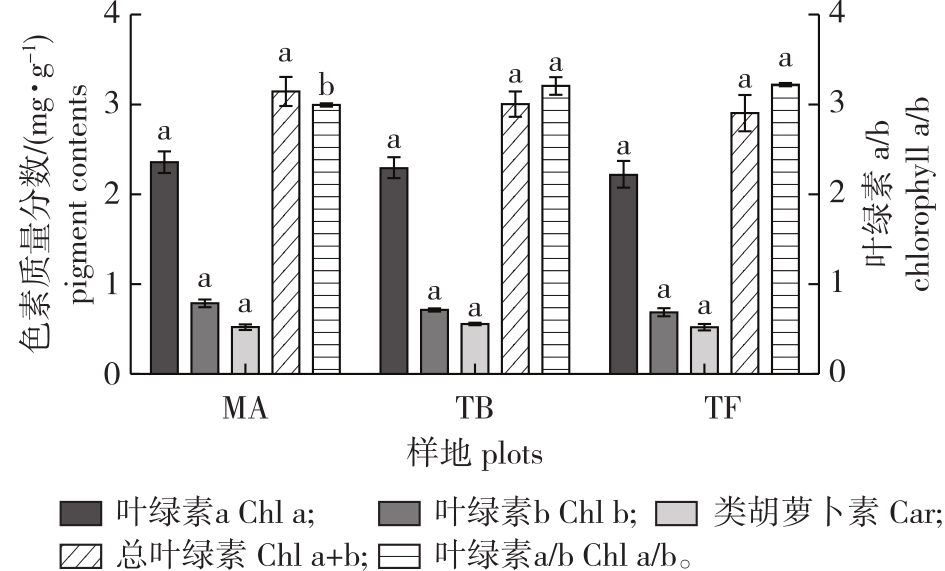 PDF(2196 KB)
PDF(2196 KB)


茶园中苦竹扩张对茶树生长和茶叶品质的影响
江秀琴, 陈双林, 凡莉莉, 胡瑞财, 郭子武, 汪忠华
南京林业大学学报(自然科学版) ›› 2025, Vol. 49 ›› Issue (4) : 152-160.
 PDF(2196 KB)
PDF(2196 KB)
 PDF(2196 KB)
PDF(2196 KB)
茶园中苦竹扩张对茶树生长和茶叶品质的影响
The variation characteristics of tea leaf quality during the expansion of Pleioblastus amarus into tea plantations
【目的】竹林扩张会造成茶园生态系统环境发生变化,形成明显的环境异质性,对茶树生长和茶叶品质产生不容忽视的影响。揭示竹林扩张对茶树生长及茶叶品质的潜在影响,为竹林扩张茶园的科学管理提供参考依据。【方法】以浙江龙游连续成片的茶(Camellia sinensis)-苦竹(Pleioblastus amarus)扩张林分为研究对象,设置3种样地,分别为茶竹混交林界面区、混交林中心区和茶树纯林区,测定茶树生长特性、茶叶色素、茶多酚、咖啡碱、游离氨基酸以及矿质营养元素含量等指标,通过多元统计方法、正交偏最小二乘法-判别分析和变量投影重要性法分析茶园苦竹扩张后茶树生长特性和茶叶品质的差异。【结果】①苦竹扩张对茶树的生长量和分叉数有明显影响,对平均高度存在显著影响(P<0.05)。②茶园中苦竹不断扩张,对茶叶色素含量无明显影响,但对混交林界面区茶叶叶绿素a/b有显著影响(P<0.05),但色素含量的差异对茶叶品质无显著影响。③受苦竹扩张影响,混交林界面区茶叶茶多酚和咖啡碱含量显著低于中心区和茶树纯林区(P<0.05),而酚氨比变化不明显,三者对茶叶品质均有重要贡献。④沿苦竹扩张茶园方向,茶叶中14种游离氨基酸组分含量呈增多的变化趋势,但混交林界面区和中心区甲硫氨酸和半胱氨酸含量显著高于茶树纯林区(P<0.05),丝氨酸含量在混交林中心区最高,但变化不明显,三者对茶叶品质具有重要贡献;⑤苦竹扩张茶园方向,茶叶中钙、锰、镁、铁和铜元素含量显著减少(P<0.05),在混交林界面区明显积累,而锌元素含量变化相反,这些矿质营养元素含量的变化对茶叶品质的差异性贡献大。【结论】苦竹扩张会引起茶树生长策略的改变,同时对茶叶的有效成分和矿质营养元素含量产生影响,进而对茶叶的品质产生影响,这种变化不利于提升茶叶的品质。
【Objective】The expansion of bamboo forests leads to environmental heterogeneity within the tea plantation ecosystem, exerting a significant impact on the growth of tea plants and the quality of tea leaves. Unveiling the potential effects of bamboo forest expansion on the growth of tea plants and the quality of tea leaves is paramount for the scientific management of tea plantations undergoing bamboo expansion.【Method】The study focused on the continuous patches of bitter bamboo (Pleioblastus amarus) and tea (Camellia sinensis) tree expansion forests in Longyou County, Zhejiang Province. Three types of plots were established, namely, the tea-bamboo mixed forest interface zone, the mixed forest center zone, and the pure tea plantation zone. Various parameters, including growth characteristics, tea pigments, tea polyphenols, caffeine, free amino acids, and mineral nutrients in tea leaves, were measured. The differences in the growth characteristics of tea trees and tea leaf quality after the expansion of P. amarus into tea plantation were analyzed using multivariate statistical methods, orthogonal partial least squares-discriminant analysis, and variable projection importance methods.【Result】(1) The expansion of P. amarus significantly influences the growth and branching number of tea plants, with a notable impact on the average height (P< 0.05). (2) With the expansion of P. amarus into tea plantations, there was no significant impact on the pigment content of tea leaves. However, there was a significant effect on the chlorophyll a/b of tea leaves in the mixed forest interface zone (P<0.05). The impact of pigments did not significantly contribute to tea leaf quality. (3) Influenced by the expansion of P. amarus, the contents of tea polyphenols and caffeine in the interface zone were significantly lower than those in the mixed forest center and pure tea plantation zones (P<0.05). The change in ratio of phenol to ammonia was not obvious, and all three parameters contribute significantly to tea leaf quality. (4) With the expansion of P. amarus into tea plantations, there was an increasing trend in the content of the 14 free amino acid components in tea leaves. However, in the mixed forest interface and center zones, the contents of methionine and cysteine were significantly higher than in the pure tea plantation zone (P<0.05). The content of serine was highest in the mixed forest center zone, but the change was not obvious. All three amino acids contributed significantly to tea leaf quality. (5) With the expansion of P. amarus into tea plantations, there was a significant decrease (P<0.05) in the content of calcium, manganese, magnesium, iron, and copper elements in tea leaves. These elements were noticeably accumulated in the mixed forest interface zone, while the zinc content exhibited an opposite trend. The variations in these mineral nutritional elements contribute significantly to the differences in tea leaf quality.【Conclusion】The expansion of P. amarus induced changes in the growth strategy of tea trees, altered the composition of effective components and mineral nutrient elements in tea leaves, thereby influencing tea quality and hindering its improvement.

茶树 / 竹林扩张 / 生长特性 / 茶叶品质 / 有效成分 / 矿质营养元素 / 苦竹
tea(Camellia sinensis) plantation / bamboo expansion / growth characteristics / tea quality / effective components / mineral nutrition elements / Pleioblastus amarus
| [1] |
|
| [2] |
|
| [3] |
黎健龙, 张曼, 唐颢, 等. 影响茶树生长和茶叶品质的主要环境因子及其适应机制[J]. 茶叶通讯, 2023, 50(4):437-445.
|
| [4] |
|
| [5] |
|
| [6] |
郭春芳, 孙云, 张木清. 不同土壤水分对茶树光合作用与水分利用效率的影响[J]. 福建林学院学报, 2008, 28(4):333-337.
|
| [7] |
|
| [8] |
刘俏, 林勇, 胡小飞, 等. 氮磷肥对茶树锌硒等中微量元素吸收与分配的影响[J]. 生态学报, 2021, 41(2):637-644.
|
| [9] |
赵阳, 杨超伟, 冯延芝, 等. 亚热带低山丘陵区桐茶复合经营对茶叶品质的影响[J]. 林业科技通讯, 2023(5):46-51.
|
| [10] |
程建新, 何玉友, 郭子武, 等. 苦竹杉木混交林界面区竹子克隆分株抽枝展叶效率变化特征[J]. 竹子学报, 2022, 41(2):24-33.
|
| [11] |
|
| [12] |
|
| [13] |
景雄, 蔡春菊, 范少辉, 等. 环境胁迫下竹类植物生态适应性研究进展[J]. 世界林业研究, 2018, 31(4):36-41.
|
| [14] |
刘希珍, 范少辉, 刘广路, 等. 毛竹林扩展过程中主要群落结构指标的变化特征[J]. 生态学杂志, 2016, 35(12):3165-3171.
|
| [15] |
黄慧敏, 董蓉, 钱凤, 等. 紫耳箭竹克隆形态可塑性对典型冠层结构及光环境的响应[J]. 生态学报, 2018, 38(19):6835-6845.
|
| [16] |
刘骏, 杨清培, 余定坤, 等. 细根对竹林-阔叶林界面两侧土壤养分异质性形成的贡献[J]. 植物生态学报, 2013, 37(8):739-749.
|
| [17] |
刘美雅, 伊晓云, 石元值, 等. 茶园土壤性状及茶树营养元素吸收、转运机制研究进展[J]. 茶叶科学, 2015, 35(2):110-120.
|
| [18] |
尹晓雷, 刘旭阳, 金强, 等. 不同管理模式对茶树碳氮磷含量及其生态化学计量比的影响[J]. 植物生态学报, 2021, 45(7):749-759.
|
| [19] |
巩雪峰, 余有本, 肖斌, 等. 不同栽培模式对茶园生态环境及茶叶品质的影响[J]. 西北植物学报, 2008, 28(12):2485-2491.
|
| [20] |
杨海滨, 盛忠雷, 谢堃, 等. 不同栽培模式对山地茶园生态环境和茶叶品质的季节调控[J]. 西南农业学报, 2015, 28(4):1559-1563.
|
| [21] |
杨丽冉, 蒋宾, 焦文文, 等. 茶李间作对茶树生长及秋季绿茶品质的影响[J]. 南方农业学报, 2023, 54(10):1-15.
|
| [22] |
高俊凤. 植物生理学实验指导[M]. 北京: 高等教育出版社, 2006.
|
| [23] |
|
| [24] |
全国茶叶标准化技术委员会. 茶咖啡碱测定:GB/T8312—2013[S]. 北京: 中国标准出版社, 2014.
National Technical Committee 339 on Tea of Standardization Administration of China. Tea-determination of caffeine content:GB/T 8312-2013[S]. Beijing: Standards Press of China, 2014.
|
| [25] |
全国饲料工业标准化技术委员会. 饲料中钙、铜、铁、镁、锰、钾、钠和锌含量的测定原子吸收光谱法:GB/T 13885—2017[S]. 北京: 中国标准出版社, 2018.
National Feed Industry Standardization Tedinical Committee. Determination of the contents of calcium, copper, iron, magnesium, manganese, potassium, sodium and zinc in feeds-method using atomic absorption spectrometry:GB/T 13885-2017[S]. Beijing: Standards Press of China, 2018.
|
| [26] |
|
| [27] |
郭舒臣, 郑玉忠, 郭瑞, 等. 不同年份老香黄定量分析及其化学模式识别研究[J]. 分析测试学报, 2021, 40(1):10-18.
|
| [28] |
王茜, 尚丽丽, 晏婷婷, 等. 不同产地沉香的高效液相色谱指纹特征[J]. 林业科学, 2021, 57(2):150-159.
|
| [29] |
高贵宾, 钟浩, 潘雁红, 等. 生态因子对美丽箬竹盆栽苗生物量分配的影响[J]. 南京林业大学学报(自然科学版), 2017, 41(5):35-41.
|
| [30] |
王叶, 张国林, 阳树英, 等. 生境对茶叶品质和产量影响的光合生理机制[J]. 应用生态学报, 2018, 29(11):3596-3606.
|
| [31] |
|
| [32] |
|
| [33] |
石浥阳, 申晓林, 王佳, 等. 芳香族氨基酸解氨酶在生物制造中的应用[J]. 生物加工过程, 2024, 22(6):611-621.
|
| [34] |
方仕茂, 张拓, 杨婷, 等. 基于HPLC-FLD靶向分析古茶树游离氨基酸积累特征[J]. 江苏农业学报, 2022, 38(4):1070-1077.
|
| [35] |
何相玉, 周冠军, 张新洁, 等. 氮磷添加对水曲柳人工林叶片、细根和土壤生态化学计量特征的影响[J]. 森林工程, 2023, 39 (1): 73-81.
|
| [36] |
黄芳, 钱佳佳, 傅秀敏. 茶叶氨基酸合成代谢及转化研究进展[J]. 中国茶叶, 2023, 45(9):10-18.
|
| [37] |
|
| [38] |
|
| [39] |
|
| [40] |
胡玉玲, 胡冬南, 周城师, 等. 施肥对赣无系列油茶叶片SPAD值及养分的影响[J]. 林业工程学报, 2011, 25(2):20-23.
|
/
| 〈 |
|
〉 |